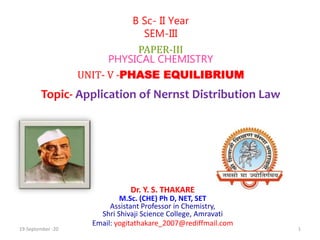
Lect. 8. application of nernst distribution law copy - copy
- 1. Dr. Y. S. THAKARE M.Sc. (CHE) Ph D, NET, SET Assistant Professor in Chemistry, Shri Shivaji Science College, Amravati Email: yogitathakare_2007@rediffmail.com B Sc- II Year SEM-III PAPER-III PHYSICAL CHEMISTRY UNIT- V -PHASE EQUILIBRIUM Topic- Application of Nernst Distribution Law 19-September -20 1
- 2. APPLICATIONS OF NERNST DISTRIBUTION LAW : • Determination of degree of association • Determination of degree of dissociation • Solvent Extraction 19-September -20
- 3. Determination of degree of association : Let in solvent B, ‘n’ number of molecules of ‘X’ associate to form ‘Xn’ molecule. In solvent A, the solute molecules remain as normal molecules. 1 2 D n C K C 19-September -20
- 4. Let C1 be c onc entration of X in solvent A. C3 be c onc entr ation of X in solvent B. C2 be c onc entration of Xn in solvent B. In this system ther e ar e two equilibr ia. Fir st equilibr ium is – X in solvent A X in solvent B. K1 1 3 C C OR C3 1 1 C K ----- (1) Sec ond equilibr ium is nX in solvent B Xn in solvent B. Fr om Law of Mass Action Kc n 2 n n 3 X C X C OR n 2 3 C C C K C2 C1 C3
- 5. Taking nth root we get, n 2 3 n C C C K ----- (2) From Eq. (1) and (2) we get 1 1 C K n 2 n C C K OR 𝐶1 𝐶2 𝑛 = K1 𝐾𝑐 𝑛 But K1 𝐾𝑐 𝑛 = KD (Constant) Thus when association occurs in one solvent the distribution equation is modified as – 𝐶1 𝐶2 𝑛 = KD As the solute exists largely as associated molecules, the total concentration of ‘X’ determined experimentally in solvent B is taken as the concentration of the associated molecules Xn.
- 6. Problem : 8 When benzoic acid was shaken with mixtures of benzene and water at constant temperature, the following results were obtained. Concentration of acid in benzene (C1) Concentration of acid in water (C2) 0.24 0.015 0.55 0.022 0.93 0.029 Determine degree of association of benzoic acid in benzene Solution : As we known, 1 n 2 C C KD Consider, C1 = 0.24 C’1 = 0.55 C2 = 0.015 C’2 = 0.022 ' 2 2 1 n ' ' ' n n 1 1 2 C C C C C C Taking log, 𝑙𝑜𝑔 𝐶2 𝐶2 ′ = 1 𝑛 𝑙𝑜𝑔 𝐶1 𝐶1 ′ 𝑙𝑜𝑔 𝐶1 𝐶1 ′ = 𝑛𝑙𝑜𝑔 𝐶2 𝐶2 ′ 0.24 0.015 log n log 0.55 0.022 n = 2
- 7. Determination of degree of dissociation : Degree of dissociation is the fraction of total number of moles dissociated at equilibrium. Let solute undergoes dissociation in solvent B and it is normal in solvent A. 1 2 (1 ) D C K C 19-September -20
- 8. Degree of dissociation is the fraction of total number of moles dissociated at equilibrium. Let solute undergoes dissociation in solvent B and it is normal in solvent A. The equilibria set up in the two solvents are shown in figure Let C1 = Concentration of ‘X’ in solvent A. C2 = Concentration of X (dissociation and undissociated) in solvent B. If degree of dissociation in solvent B is ‘ α’ then. X Y + Z Initially 1 0 0 At equilibrium (1 ) Hence, the concentration of the undissociated (normal) molecules in solvent B is C2(1– ). Applying distribution law to normal molecules in the two solvents, 1 D 2 C K C (1 ) This is modified equation in dissociation case. C1 C2
- 9. Problem : 9 Succinic acid is distributed in water and ether. In aqueous solution it undergoes dissociation. The concentration of acid in aqueous layer was 42.5 x 10-3 kg dm-3 and ether layer was 7.1 x 10-3 kg dm-3 . If distribution co-efficient of acid is 0.25, calculate the degree of dissociation assuming the normal molecules in ether. Solution : Given That Concentration in aqueous layer (C2) = 42.5 x 10-3 kg dm-3 Concentration in ether layer (C1) = 7.1 x 10-3 kg dm-3 Distribution coefficient = (KD) = 0.25 We know, 1 D 2 C K C (1 ) 3 3 7.1 10 0.25 42.5 10 (1 ) 1 - = 0.6666 = 0.3334 % = 33.34 %
- 10. EXTRACTION Simple Extraction Multiple Extraction There are two types of extraction 19-September -20
- 11. Solvent Extraction Solvent extraction and is a method to separate compounds based on their relative solubilities in two immiscible liquids, usually water and an organic solvent. 19-September -20 19-September -20
- 12. • Simple Extraction: The extraction process when carried out with the total amount of given organic solvent in a single step is known as simple extraction. • Multiple Extraction: When the extraction is carried out in more number of steps by using small amounts of organic solvent from total solvent with same aqueous solution is known as multiple extraction.
- 14. Applications: 1. In Pharmaceutical Chemistry Separation of many antibiotics, vitamins and harmones 2. Food Industry 3. In Nuclear chemistry 4. Fiber Industry 5. Extraction of essential oil, flavoring etc. 6. Extraction of Caffeine from coffee and tea. 7. Removal of phenol from the Waste water. 8. Recovery and purification of acetic acid from aqueous streams. 9. Extraction of antibiotics and organic acids from fermented broth. 10.Seperation and refining of petrochemicals and petroleum
- 15. References: • Instrumental methods of Chemical Analysis Gurdeep R. Chatwal Sham K. Anand • Instrumental Methodology and Chemical Analysis H. Kaur • Insrumental methodology of Chemical Analysis B. K. Sharma • Textbook of Chemistry for 3rd Semister of Bsc. • Basic concept of analytical chemistry By S. M. Khopkar
